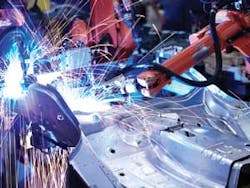Precision Metalformers Make Headway Despite Government Actions
Despite such uncertainty, the precision metalforming sector shows signs of recovery. Gaskin says that for the first eight months of 2011, sector shipments were 11 percent better than for 2010 and “on orders, it’s 10 percent.” The numbers are better than the news media and government report, he says, adding, “We’re far away from a recession in metalforming.”
But, Gaskin notes that July and August negative press about the U.S. debt limit, coupled with Congress’ simultaneous inaction, affected precision metalforming. “They [Congress and the President] kicked the can down the road. They say words, but present no true action plan. Nor is there sufficient bipartisanship to deal with the issues businesses face,” he believes.
One principal issue is taxation. Small business characterizes precision metalforming, Gaskin explains. Typical companies are either Subchapter S corporations or limited liability companies (LLCs). Subchapter S may be better suited to small businesses where owners prefer being taxed as if they were sole proprietors or partnerships. Being an LLC allows a corporation’s limited liability protection but taxation of a sole proprietorship or partnership.
Currently, “they [the Subchapter Ss and LLCs] have been hearing or reading about Congress thinking about changing taxes—lowering some rates—for businesses. But what they [Congress and President] are not talking about is the 63 percent or 64 percent of our members or other small businesses that are LLCs, where owners pay personal taxes on company profits,” Gaskins says.
Those mixed messages generate confusion. “While our members hear Congress talk about tax reform for corporations, President Obama talks about increasing taxes for people making $250,000 annually,” Gaskin relates. But he emphasizes, “If you’re a small business and you’re not making more than $250,000 annually, you’re out of business.” That’s due to capital requirements—e.g., equipment, staff, handling government regulations, etc.—to operate a manufacturing facility, he adds.
Stricter Rules
The EPA’s Air Toxics Web site (www.epa.gov/ttn/atw/boiler/boilerpg.html) notes that, as of May 18, 2011, EPA has delayed the rule’s effective date pending completion of reconsideration or judicial review.
Another government burden Gaskin mentions is a proposed modification of a U.S. Occupational Safety and Health Administration (www.osha.gov) rule. “They were going to change the way the word ‘feasible’ has been used, since the 1980s, in enforcing the OSHA noise standard,” Gaskin says.
In October 2010, the Arlington, Va.-based International Safety Equipment Association (www.safetyequipment.org) explained it thusly: “There is a condition in the regulations that says the administrative or engineering controls used to limit noise must be feasible, which OSHA has long interpreted as meaning less costly than an effective hearing conservation program using monitoring, testing, training and PPE [personal protective equipment]. Now, OSHA wants to revise that policy, interpreting feasible to mean ‘capable of being done’ and setting a new threshold for affordability.”
In the wake of business protests, OSHA delayed rule modification in late January 2011, suggesting more public outreach was needed and apparently doing research on how to differently abate workplace noise. “This was a good thing,” Gaskin remarks.
What may not be a good thing, though, is manufacturers’ reluctance to make significant capital investments. “Lack of consumer demand, government regulations, uncertainty and taxes—for these reasons, it’s no wonder people are sitting on money,” Gaskin says. Another reason he cites is that PMA members and others cannot find trained employees for jobs that do exist.
“Manufacturing in America suffers from lack of national political leadership that causes uncertain economic and regulatory environments that threaten businesses’ ability to compete in the global economy,” Gaskin stresses. Even so, he notes that about 80 percent of PMA members have forecast growth in incoming 2011 orders. “Last year, we had 75 percent of our members say growth would either hold steady or grow.”
Though slight, that’s still recovery.
C. Kenna Amos, [email protected], is a Contributing Editor for Automation World
About the Author
C. Kenna Amos
Contributing Editor

Leaders relevant to this article:
